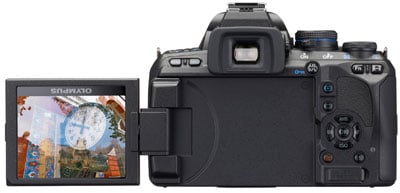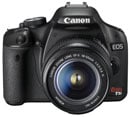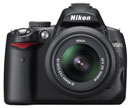Olympus E-620
-
-
Written by Gordon Laing
Olympus E-620 verdict
The Olympus E-620 is a feature-packed DSLR which offers a step-up from entry-level models. Like many DSLRs these days, it inherits a number of features from a higher-end model, in this case, the E-30, but packages them into a smaller, lighter and more affordable package. By doing so, it also addresses most of the criticisms of the earlier E-520 and E-420.
The E-620 essentially starts with the popular E-520 with its built-in stabilisation, takes the higher resolution sensor, Art Filters and articulated screen of the E-30, then squeezes it all into a smaller body that’s closer in size and style to the E-4xx series.
On top of that, the regularly-criticised 3-point AF system and tiny viewfinders of the E-5xx and E4xx series have both been upgraded, there’s a wealth of customisation options and you still get the best anti-dust system on the market. Olympus really has done its homework here, delivering a camera, which on paper anyway, features just about everything a modern DSLR buyer is looking for, while additionally resolving almost every issue levelled against previous models.
We’re pleased to report the E-620 lives up to much of its promise. The body is a triumph of ergonomics and engineering, packing image stabilisation and an articulated screen into a relatively tiny but sturdy body that’s comfortable to hold and use. Ever the innovators, Olympus have also employed backlit buttons on the rear which really do aid operation under dim conditions. Unlike many budget DSLRs, there’s also an optional battery grip, and even an underwater housing available.
The built-in Image Stabilisation, like other E-series bodies with the facility, provides anti-shake capabilities for any lens you attach. Like the E-520 before it, we ‘only’ typically enjoyed two to three stops of compensation rather than the quoted four, but it remains an extremely valuable facility, and one that’s even more impressive to find in such a small body.
The articulated screen is another valuable addition, making composition in Live View much more useful. You can easily twist the screen to remain visible with the camera held at ground level or over the heads of crowds, or flip it back to face the subject in a self-portrait. Again the camera’s small size hasn’t compromised the construction of the hinge system, which feels strong and smooth in use. Unlike the Nikon D5000, it’s also hinged at the side, allowing complete flexibility whether mounted on a tripod or not.
Like earlier E-series DSLRs, there’s pros and cons to the image quality. At lower sensitivities, the E-620’s images are packed with detail, and thanks to a decent kit lens, are also respectably sharp to the edges. Certainly as our first results page shows, the E-620 kit can out-perform the Canon EOS 500D / Rebel T1i kit in a number of respects, despite the bigger sensor and three extra Megapixels of its rival. But at higher sensitivities, noise becomes more apparent on the E-620 than the competition, particularly at 800 ISO and above.
As before, this is something you have to weigh-up for yourself. If you regularly shoot at high sensitivities, then there’s simply better options available, especially Nikon’s D5000. But if you mostly use 400 ISO or below, the E-620 performs well, while also having the crucial benefit of some of the best quality lenses available for any system.
 |
The optical viewfinder is definitely larger than the E-5xx and E-4xx models and now also thankfully shows sensitivity at all times. But even though it matches the height of several rival viewfinders, the squarer 4:3 aspect ratio of the sensor means the view is narrower – so it still looks a little smaller overall. But any improvement here is welcome.
Sticking with composition, the articulated screen, like that on the Nikon D5000, is a double-edged sword. The flexibility is genuinely useful when composing in Live View, but remember focusing in Live View is relatively slow, so you’ll mostly only be exploiting it for relatively static compositions. Photos of a toddler running towards you from a low angle, or passing celebrities grabbed from above the heads of crowds may not be possible.
The screen itself, while good-looking and impressively visible under direct sunlight, is also smaller and less detailed than the fixed 3in VGA panels of models like Canon’s EOS 500D / T1i. So again you have to think carefully about which kind of display will work best for your requirements.
On a different note, Olympus makes a big noise about its Art Filters, inherited here from the E-30. These can look fun and are certainly easy to apply, but similar results can be achieved using software afterwards. Of course the point here is you don’t need a computer to do it, which may be useful if you’re IT-phobic, or want to print directly from the camera or memory card, but we can’t help but feel Olympus is slightly over-egging their importance.
Finally, while the E-620 packs a large number of features into a relatively small body, video recording isn’t one of them. Now while many people don’t see the point of video on a DSLR, and it’s true existing solutions suffer from a number of restrictions, it is a headline feature today and notable by its absence here; there’s also no HDMI port.
Olympus can’t pull the ‘traditionalist’ excuse either, as it regularly lead the field in gadgetry including Live View. If you don’t care about movies, you can happily move-on, but if it’s an important feature for you in your DSLR, you’ll need to look at rivals like the Canon EOS 500D / T1i or Nikon D5000 instead.
Speaking of rival models, let’s see how the Olympus E-620 stacks-up before our final verdict.
Compared to Olympus E-520
The E-520 was one of last year’s best-selling DSLRs, and slots between the E-620 and E-450 in the current range. Olympus claims the E-520 will continue to sell alongside the E-620, but we believe this will only be in the short term while stocks last. Both cameras feature similar controls, the same kit lens, built-in Image Stabilisation, SSWF anti-dust, and 2.7in / 230k screens with Live View facilities, but the E-620 features a number of improvements. These include two extra Megapixels, a fully-articulated screen, a 7-point AF system (versus 3-point), quicker continuous shooting (4fps vs 3.5fps, although both cameras performed similarly in our tests), a series of Art Filters, double the maximum sensitivity, a slightly bigger optical viewfinder with ISO visible at all times, AF micro-adjustment, multiple aspect ratios, and an official battery grip accessory. The E-620 is also a little smaller and lighter, without compromising comfort in our view. So while the continuous shooting worked out roughly the same speed in our tests, the E-620 offers a wide variety of improvements over its ‘predecessor’ – maybe not enough for existing E-520 owners to upgrade, but certainly sufficient to tempt new buyers. In its favour, the E-520 is of course cheaper, while still offering the key features of built-in IS, great anti-dust and a compact body with decent controls and live view facilities. If you don’t need the E-620’s extra features, it remains a great choice and better value than ever. See our Olympus E-520 review for more details. |
Compared to Olympus E-30
The Olympus E-30 is the next model up in the Olympus range and a number of its features were inherited by the E-620. Both cameras share the same stabilised sensor, a 2.7in / 230k fully-articulated monitor, SSWF anti-dust system, and the six creative Art Filters. The E-30 does of course continue to sport several key advantages over the E-620 though: a bigger and brighter penta-prism viewfinder, an 11-point AF system (compared to 7-point), quicker continuous shooting (5fps vs 4fps), a faster maximum shutter speed of 1/8000, a PC Sync terminal for studio lighting, a DC input, more effective IS (5 stops vs 4), more aspect ratios, greater multiple exposure capabilities, and a dual-axis digital level. The E-30’s larger body with upper LCD screen and dual control dials is also better-suited to higher-end photographers, although it is heavier. In its favour, the E-620 is smaller, lighter and its monitor is actually a newer generation, albeit the same size and resolution. The E-620 also offers an optional underwater housing and is of course cheaper too. While the E-620 shares much in common with the E-30, enthusiasts and semi-pros will ultimately prefer the higher-end features and handling of the pricier model. It also represents a more sensible step for existing E-520 owners looking for a more sophisticated upgrade than the E-620. |
Compared to Canon EOS 500D / Rebel T1i
The Canon EOS 500D / Rebel T1i costs more than the E-620, but is likely to become a major rival none-the-less. In its favour, the EOS 500D / T1i boasts a higher resolution (15.1 Megapixels versus 12.3), greater maximum sensitivity (12800 ISO compared to 3200), deeper tonal depth (14 bits versus 12), the screen is bigger and more detailed (3in VGA vs 2.7in QVGA), the viewfinder slightly larger and there’s also an HD movie mode. Again like all Canon DSLRs, you also get free PC / Mac based remote control and decent RAW conversion software. In our tests the Canon also performed better at the highest sensitivities, but at lower ones the actual real-life detail was similar. In its favour the E-620 features built-in Image Stabilisation which works with any lens you attach, a fully articulated screen which allows great compositional flexibility in Live View, faster continuous shooting on paper (although roughly the same speed in our tests), a series of artistic in-camera filters, and is slightly smaller and lighter, without compromising comfort or ergonomics; there’s also an optional underwater housing available, and the E-620 is cheaper too. Ultimately it boils down to choosing the feature-set which best-suits your requirements, not to mention the ergonomics and price. Canon’s EOS 500D / T1i certainly has a great deal going for it, and if you can exploit its higher resolution with better lenses, prefer its fixed but larger and more detailed screen, or just fancy the idea of HD videos, then it could be worth spending the extra. See our Canon EOS 500D / Rebel T1i review for more details. |
Compared to Nikon D5000
The Nikon D5000 is another DSLR coming in at a higher price than the E-620, but like the Canon 500D / T1i, it’s still likely to become a major rival for the new Olympus. Both models also have several things in common, including 12 Megapixel resolution and fully-articulated 2.7in screens. In its favour, the D5000 features an HD movie mode, an HDMI port, double the maximum sensitivity, a more sophisticated 11-point AF system (compared to 7-point), interval shooting, a time-lapse movie mode and on-demand guidelines in the viewfinder. The D5000 also has a physically larger sensor which as you’d expect, allow it to deliver lower noise levels at high sensitivities. In its favour the E-620 features built-in Image Stabilisation which works with any lens you attach, a more sensibly-located hinge for the screen, depth-of-field previews, a live histogram in live view, a series of artistic in-camera filters, and is also smaller and lighter, without compromising comfort or ergonomics; there’s also an optional battery grip and even an underwater housing available, and once again the E-620 costs less. As before though, it boils down to choosing the feature-set which best-suits your requirements, along with the price and ergonomics. The D5000 is certainly a very capable DSLR with the double-whammy of beginner-friendly guides and great image quality at higher sensitivities. If either are a priority for you, then it could be your best bet. See our Nikon D5000 review for more details. |
Also consider
If you’re after a camera with a DSLR-sized sensor, removable lenses, an articulated screen and proper 1080p HD movie recording, you should also be considering Panasonic’s Lumix DMC-GH1 – although unlike the models above, its video recording and Live View functions are core features rather than being bolted-on and compromised in some respects. It looks pricey at roughly twice the price of the E-620 (check latest USA price here), but the standard kit comes with a 28-280mm equivalent super-zoom lens with smooth aperture adjustment designed for video. See our Panasonic Lumix DMC-GH1 preview for more details.
Olympus E-620 final verdict
Olympus has done a great job with the E-620, delivering a feature-packed DSLR that’s great fun to use, yet has enough sophistication to keep demanding enthusiasts happy. The company has struck a great balance in the design, producing a camera that’s sufficiently small to never feel a burden, without compromising comfort, build or ergonomics. If you were attracted to the size of the E-420, but wanted the stabilisation of the E-520, this is the camera for you. The feature-set is also impressive with built-in anti-shake, a fully-articulated screen, considerable customisation and the most effective anti-dust system of any DSLR we’ve tested.
Unless you’re bothered by the lack of a movie mode and HDMI port, the only real – or at least, perceived – concern lies with the high ISO performance. As you can clearly see in our results pages, rival DSLRs with physically bigger sensors can deliver lower noise above 400 ISO; the Nikon D5000 performs particularly well in this regard.
At this point, many reviews of Four Thirds cameras come to the same conclusion: nice camera, shame about the noise. But is it really a deal-breaker? Noise levels are easy to measure and illustrate, and hence are a favourite for both reviewers and enthusiasts to compare. They are undoubtedly an important factor in DSLR performance, but it’s crucial to choose a camera based on your needs, not someone else’s.
If you regularly shoot above 400 ISO and demand low noise, then there’s better choices out there, particularly the Nikon D5000. But if most of your shots are taken at lower sensitivities, or the noise in our results pages look fine to you, then the E-620 is a fine choice. Remember while the Four Thirds system is often criticised for higher noise levels than rivals, the flip-side to the coin is it boasts some of the very best lenses around (including respectable kit models), not to mention the most effective anti-dust system on the market. So it’s all about figuring out where your own priorities lie.
There’s one other thing we should mention. Throughout this review we’ve compared the E-620 against the Canon 500D / T1i and Nikon D5000 and seen how each model has its pros and cons. The E-620 has one trump card remaining though, and that’s the price. These three cameras may have started as rivals, and all represent a step-up from entry-level models, but at the time of writing, you could buy an E-620 kit for around 25% less than either the Canon or Nikon. Or for just a little less than either rival kit, you could have the E-620 with not one, but two lenses, giving you a total equivalent coverage of 28-300mm.
Ultimately the E-620 represents great value and is a DSLR we can whole-heartedly recommend. As always though, be sure to think carefully about your personal requirements and closely compare the features and image quality of its rivals. The E-620 is a great DSLR for the money, but the Canon 500D / T1i and Nikon D5000 also have a great deal going for them.
Bad points | Scores (compared to 2009 budget DSLRs) |
 | ||
Build quality: Image quality: Handling: Specification: Value:
Overall: |
17 / 20 17 / 20 18 / 20 18 / 20 18 / 20
88% | |||







